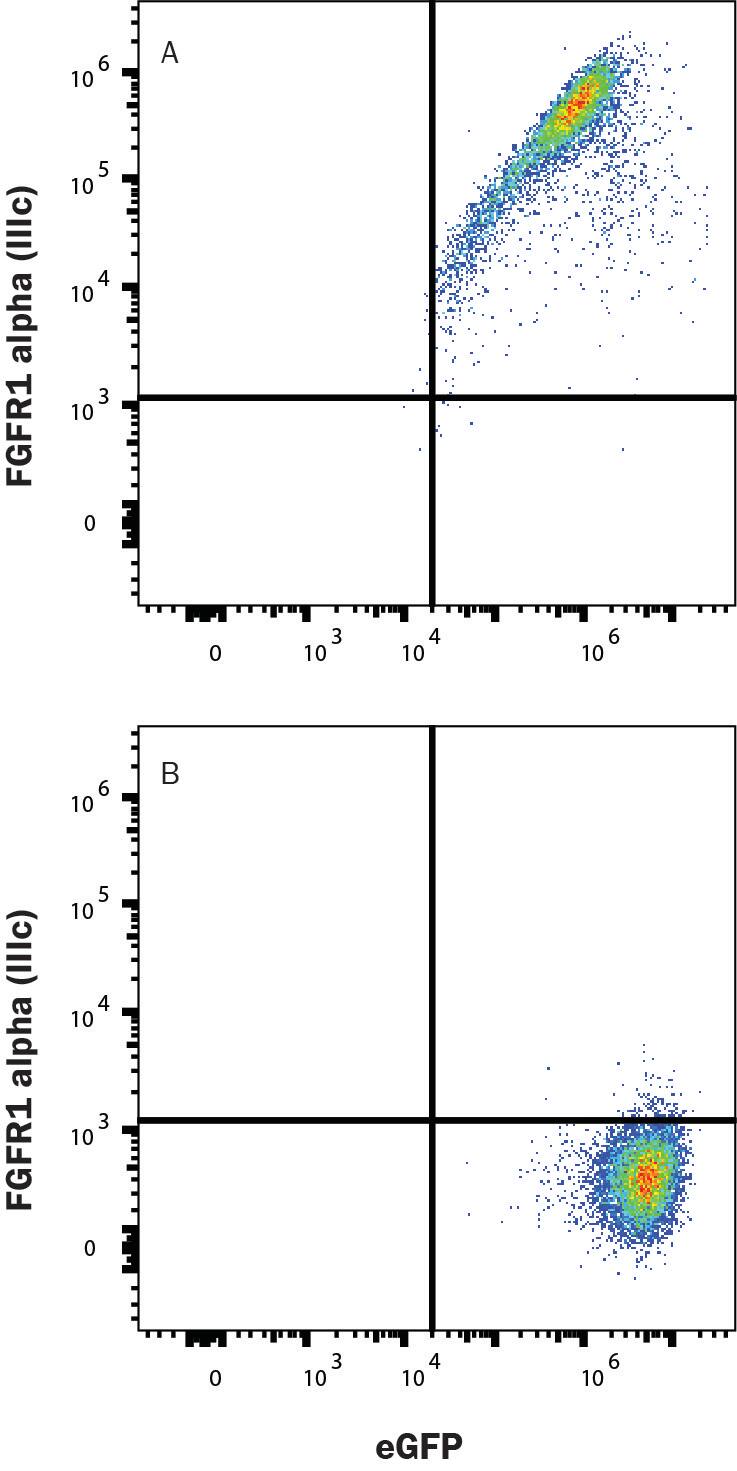Human FGFR1 alpha (IIIc) APC‑conjugated Antibody
R&D Systems, part of Bio-Techne | Catalog # FAB11336A

Key Product Details
Species Reactivity
Human
Applications
Flow Cytometry
Label
Allophycocyanin (Excitation = 620-650 nm, Emission = 660-670 nm)
Antibody Source
Monoclonal Mouse IgG2B Clone # 1058809
Product Specifications
Immunogen
Human embryonic kidney cell, HEK293-derived human FGFR1 alpha
Arg22-Glu376
Accession # P11362.3
Arg22-Glu376
Accession # P11362.3
Specificity
Detects human FGFR1 alpha (IIIc) in direct ELISA
Clonality
Monoclonal
Host
Mouse
Isotype
IgG2B
Scientific Data Images for Human FGFR1 alpha (IIIc) APC‑conjugated Antibody
Detection of FGFR1 alpha in HEK293 cells by Flow Cytometry.
HEK293 cells transfected with Human FGFR1 and eGFP (A) vs irrelevant and eGFP (B) were stained with Mouse Anti-Human FGFR1 alpha APC-conjugated Monoclonal Antibody (Catalog # FAB11336A) followed by Allophycocyanin-conjugated Anti-Mouse IgG Secondary Antibody (Catalog # F0101B). View our protocol for Staining Membrane-associated Proteins.Applications for Human FGFR1 alpha (IIIc) APC‑conjugated Antibody
Application
Recommended Usage
Flow Cytometry
10 µL/106 cells
Sample: HEK293 cells transfected with Human FGFR1 and eGFP vs irrelevant
Sample: HEK293 cells transfected with Human FGFR1 and eGFP vs irrelevant
Formulation, Preparation, and Storage
Purification
Protein A or G purified from hybridoma culture supernatant
Formulation
Supplied in a saline solution containing BSA and Sodium Azide.
Shipping
The product is shipped with polar packs. Upon receipt, store it immediately at the temperature recommended below.
Stability & Storage
Protect from light. Do not freeze.
- 12 months from date of receipt, 2 to 8 °C as supplied.
Background: FGFR1 alpha
References
- Ornitz, D.M. and Itoh, N. (2015) Wiley Interdiscip. Rev. Dev. Biol. 4:215.
- Zhang, X. et al. (2006) J Biol. Chem. 281:15694.
- Ferguson, H.R. et al. (2021) Signaling Cells 10:1201.
- Holzmann, K. et al. (2012) J Nucleic. Acids 2012:950508.
- Xie, Y. et al. (2020) Sig. Transduct. Target Ther. 5:181.
- Mossahebi-Mohammadi, M. et al. (2020) Front Cell Dev. Biol. 18:79.
- Hughes, S.E. (1997) J. Histochem. Cytochem. 45:1005.
- Delezoide, A.L. et al. (1998) Mech. Dev. 77:19.
- Yamashita-Sugahara, Y. et al. (2016) Sci. Rep. 6:35908.
- Teven, C.M. et al. (2014) Genes Dis. 1:199.
- Babina, I. and Turner, N. (2017) Nat. Rev Cancer 17:318.
Long Name
Fibroblast Growth Factor Receptor 1 alpha
Alternate Names
FGF R1a
UniProt
Additional FGFR1 alpha Products
Product Documents for Human FGFR1 alpha (IIIc) APC‑conjugated Antibody
Product Specific Notices for Human FGFR1 alpha (IIIc) APC‑conjugated Antibody
For research use only
